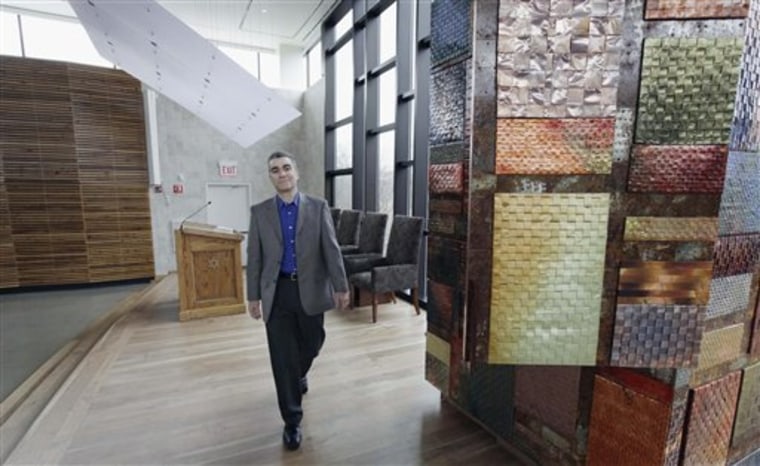When it rained, water filled the basement a foot high, flooding the preschool room at least once a year. The air conditioner wouldn't work in two rooms at the same time. The Jewish Reconstructionist Congregation desperately needed a new synagogue.
As members planned their new building, they decided it should reflect the belief, shared by many faiths, that God calls them to be responsible stewards of the earth.
They decided to go green from the ground up.
Cypress wood reclaimed from barns in upstate New York was used for the new synagogue's exterior, white cinder blocks from the old building were crushed and recycled, and brown cabinet doors made from sunflower husks were hung in the offices.
As Americans are becoming more environmentally conscious, more religious groups are looking to make their worship spaces sustainable. The efforts range from small country congregations using energy-efficient bulbs to megachurches complying with complex green-building codes.
"It was about making a sacred statement," Rabbi Brant Rosen said of the synagogue in Evanston, a Chicago suburb. "If we were going to talk the talk, we needed to walk the walk. The whole process forced us to look at our values in a deeper way."
The $9 million synagogue opened in February 2008 and in September became the only house of worship in the country to receive the highest green-building rating from the nonprofit U.S. Green Buildings Council, whose standards are considered the benchmark for environmentally friendly buildings.
10 LEED houses of worship
Since 2005 just 10 congregations have received the council's certification for environmentally friendly buildings, called the Leadership Energy Environmental Design, or LEED, certification. Another 54 congregations have applied.
Among the applicants are seminaries, chapels, sanctuaries, monasteries, student centers and church offices. They are Jewish, Roman Catholic, Methodist, Mennonite, Presbyterian, Unitarian, Wesleyan and Lutheran.
"They believe that God calls them to become better environmental stewards and they see this as a way to express that," said the Rev. Fletcher Harper, chairman of Green Faith, an interfaith group in New Brunswick, N.J., dedicated to the environment. "And they want to make good and responsible use of their congregation's financial resources."
By going green, most worship buildings can cut their energy costs by 30 percent, said Jerry Lawson, of the Environmental Protection Agency's Energy Star Congregations program. About 2,000 of the nearly 310,000 houses of worship in the U.S. participate in the EPA program.
"That's a lot of money that can go back into the mission," he said. "Why waste the money the members of the congregation have donated to operate and maintain your building?"
Houses of worship often have specific environmental needs, he said. For instance, stained glass windows could be insulated from weather and pipe organs protected from humidity, but this would require additional expense up front before any energy savings could be realized.
The green efforts of the Jewish Reconstructionist Congregation added $750,000 to the cost.
Church halved its gas/water budget
In Plano, Texas, the 27,000-member Prestonwood Baptist Church worked with Energy Star Congregations to halve its annual $2 million bill for gas and water, executive pastor Mike Buster said.
"We're to be good stewards of our resources, our financial resources as well as the Earth's resources," Buster said. "We take the dollars we were spending with utility companies and now spend them on ministry and missions."
Green building wasn't on the congregation's radar when Pulaski Heights United Methodist Church in Little Rock, Ark., started construction in 2005. But once church members learned about it, they took to the idea. Now the LEED-certified church has a green section in its newsletter, where members have been asked to bring in their electronics, like computers and DVD players, for recycling.
"It's taken on its own life," said Jan Meyer Swindler, who was on the church building committee. "We sold recycled grocery bags. The plastic foam cups have gone away. Little by little you see changes and that's what it's all about."
In Evanston, the Reconstructionist congregation is encouraging every member to adopt environmentally friendly practices at home, too.
The Rev. Elaine Strawn of Unitarian Universalist Fellowship of Wayne County in Wooster, Ohio, said her 123-member congregation outgrew their old building and decided to go green for the new one. Congregants see having an environmentally friendly space as a reflection of their spirituality.
"We're caretakers," said Strawn, whose church is also LEED certified. "It's respecting other life and trying to reduce our impact so future generations have some Earth left to live on."
The interest in having environmentally sound religious spaces is just beginning, Harper said.
"There's a long-term trend that's very powerful and unmistakable," Harper said. "The only financially responsible way for religious groups to build is to pay attention to green building."
